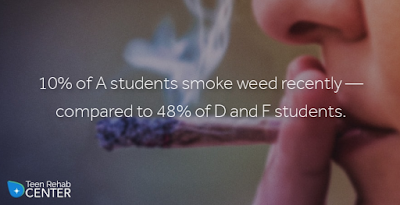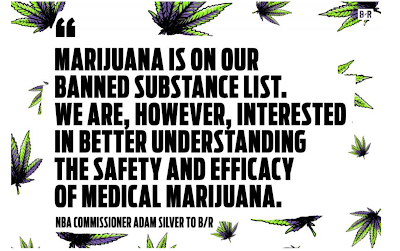"Get it right." You're asked to see Mr. Smith for cancer, a life-changing diagnosis. You walk into the room, realize that THIS Mr. Smith is 37 years old and you expected someone 77 years old. You apologize. You're in the wrong room. Good bloggers check facts.
Basketball and blogging aren't life and death, but readers expect correct, researched information. Baseball suspended star Robinson Cano eighty games for failing its drug policy. We almost never hear of an NBA player failing drug testing. What does that mean?
Base rates for marijuana use indicates that about a third of high school seniors have smoked marijuana in the past year.
This is the NBA collectively bargained drug policy:
"All players are subject to four (4) random tests each season (from October 1 to June 30). All players are also subject to two (2) random tests each off-season (from July 1 to September 30). All such tests are scheduled and conducted by an independent, third-party entity and are without prior notice to the player. The NBA and the NBPA are not involved in the scheduling of any tests or the selection of players for testing."
Additionally from the NBA drug policy, "urine samples collected during the Off-Season will be tested for SPEDs and Diuretics only and may not under any circumstances be tested with respect to any other Prohibited Substances." Also, "No penalty of any kind will be imposed on a player as a result of having Come Forward Voluntarily for a problem involving the use of marijuana."
An extensive ESPN article about drug testing questioned the use of PEDs in the NBA. "Baccus essentially said he did not think performance-enhancing drugs would help in the NBA, and had thrown out nearly 90 percent of the league’s positive tests in six years. This may mean nothing other than that the league is exercising due caution in avoiding false positives." We might ask, "why would enhanced size, strength, and power be an advantage?" Seriously?
Human growth hormone (HgH) is particularly challenging. An Orthopaedic surgeon told me once, "HgH is like having the fountain of youth." I'm not sure how he knew.
The ESPN piece notes that advanced notification, microdosing (of PEDs), dilution (saline injections), and masking agents can all indemnify participants. Players also know their "glowtime" the time between use and positive testing.
Anecdotally, regular marijuana users report positive testing for over six weeks after stopping.
Jay Williams reported that eighty percent of NBA players used marijuana. With medical marijuana legal in almost thirty states and recreational marijuana legality increasing, that shouldn't shock anyone.
Practically speaking, professional athletes would be concerned about benzodiazepines (tranquilizers, possibly sleep aids), cannabis (marijuana), cocaine, and opioids. Propoxyphene is no longer used. Physicians prescribe benzodiazepines for sleep and anxiety and narcotics for pain. Longer-term, medical marijuana, generally some combination of THC and CBD (cannabidiol) could become substitutes for some narcotic pain treatment. What is NOT widely known is that CBD is a form of medical marijuana that is non-euphoric and therefore has no incentive for habituation.
With the proliferation of legal and medical marijuana, NBA top executives are reviewing the status of medical marijuana.
The NBA introduced Human Growth Hormone (HgH) testing for the 2015-2016 season...three tests per year, two in-season. The list of NBA PED suspensions is vanishingly small with only seven players most recently Joakin Noah in 2017.
What we know is that there's no PED problem in the NBA. They told us so.




